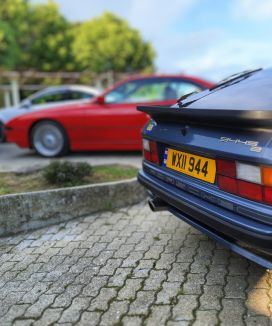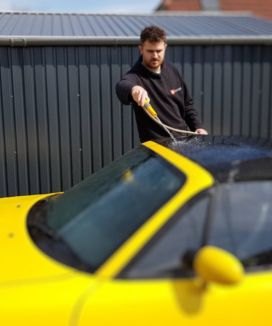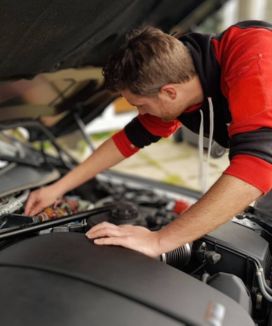How To Prevent Rusting on Cars (The 7 Best Ways)
Table of Contents
Table of Contents
If you love your car as much as your children, then the last thing that you want is rust forming all over it.
Rust can not only damage the bodywork, but the structural elements as well. Once rust is present, it can quickly turn into a major issue for your car, even causing damage to engine components under the hood.
Fixing it can lead to some seriously expensive bills. As such, it’s important that you do everything you can to prevent it forming.
So, here are the best ways to prevent rusting on your car:
Wash your car regularly
One of the leading causes of rust forming on cars is a lack of proper cleaning, or because they’re not cleaned on a regular basis.
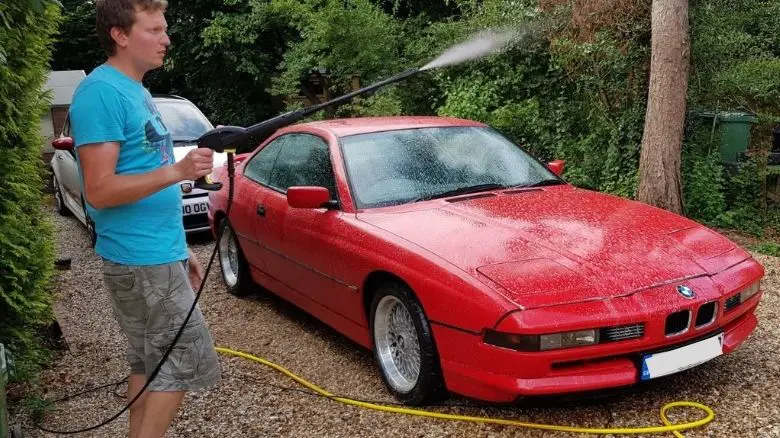
When you fail to wash your car, large amounts of dirt will accumulate pretty much everywhere, but especially on the underside of the vehicle and around the wheel arches.
This can seriously increase the rate of corrosion on your car, leading to long-term, and sometimes irreversible damage.
To prevent rust forming on your car, you should wash your car at least twice a month, and even more regularly during the winter months.
Washing your car doesn’t just mean using a hose either. Spend at least an hour jet washing, shampooing, drying and waxing your car. Learning how to wash your car properly is an art form in itself.
Not only will this keep your car looking brand new, but it will also keep the metal in good condition for longer.
Use a ceramic coating on your car
Before ceramic coating was developed, one of the best ways to protect your car from rust was to use car wax. This can be applied after you wash your car, and remains a great way to protect your car’s exterior.
However, car wax has a few downsides. The main disadvantage is that car wax is only effective for a month or two. So, you’d regularly have to spend time applying the wax.
However, there is an alternative, and it’s simply great. Ceramic coating is a liquid polymer that is applied to a car’s paint.
This coating lasts around 2-3 years, and does an absolutely excellent job at stopping your car from rusting by providing it with an effective and durable protective layer.
It’s much more time-efficient than applying car wax, although it is recommended that you use a qualified professional to apply it as it is more difficult to use than car wax.
So, if you’re looking for a great way to prevent rusting on cars for a sustained period of time, look no further than the incredibly durable ceramic coating.
Apply anti-rust spray
Sometimes, rust will appear before you have a chance to stop it. Paint bubbling is a clear indicator that you’ve got a small accumulation of rust on your car.
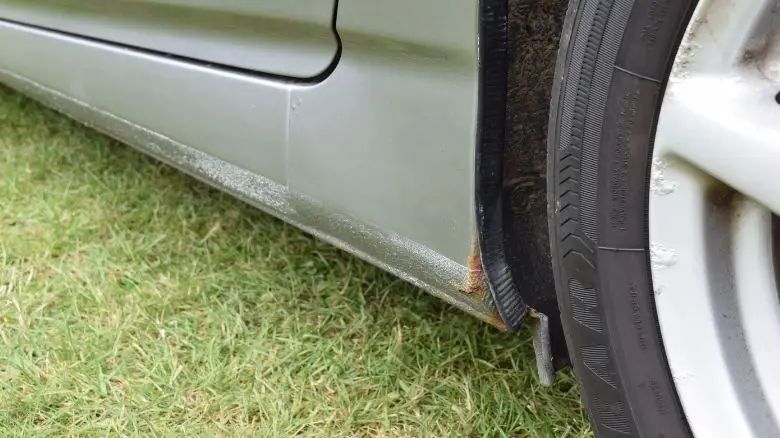
When this happens, many think that the damage is irreversible. But, in some cases there is at least a way to prevent it from getting worse.
If you start to see rust building up on your car, then you can apply anti-rust spray to treat the surface of the metal. This protects it from further damage by repelling the elements that lead to rust.
Anti-rust spray is very cheap, but effectiveness and durability can vary from product to product.
Although it’s not going to restore the panel to its former glory, it can certainly help if you catch the rust early enough.
If you’re only interested in prolonging the life of the car, it’ll be much more cost-effective than taking your car to the bodyshop, who may suggest that you need a whole new panel for your car.
Applying anti-rust spray is very simple. All you have to do is thoroughly dry the affected area, then apply your spray.
Make sure your interior is dry
Believe it or not, moisture inside your car’s cabin can cause a built-up of rust without you realizing it. This is because when there is moisture inside your car, it can seep through the carpets, seats, and other material inside your car.
There may be no visible sign of rust developing until you lift the mats and examine the floor of your car, by which point it could be too late.
To prevent this, ensure that you remove any sources of moisture, such as wet coats and umbrellas, from the inside of your vehicle as soon as possible.
Whenever you see any moisture inside your car, wipe it down with a microfibre cloth. It’s a great idea to keep one in your car at all times so whenever you see any moisture you can get rid of it immediately.
But don’t leave a wet cloth inside, or you’ll find the moisture simply remains inside.
If you ever spill a drink in your car, don’t just leave it. Soak up what you can with a cloth or towel, and then use a water hoover to get rid of any excess moisture.
Not only will this prevent your seat or flooring from being stained, but it will also help to prevent the build-up of rust inside your car.
Make sure the window seals are in good condition, and use a car dehumidifer to remove excess moisture if you’re finding it challenging to keep the interior dry.
Get rid of any salt on your car
When it comes to preventing rust on your car, salt is the enemy. When it’s combined with oxygen and water, it aggressively corrodes metal five to 10 times quicker than water alone.
Many people think that the higher likelihood of rust developing during the winter months is because of the cold weather, but it’s actually down to the extra salt on the roads.
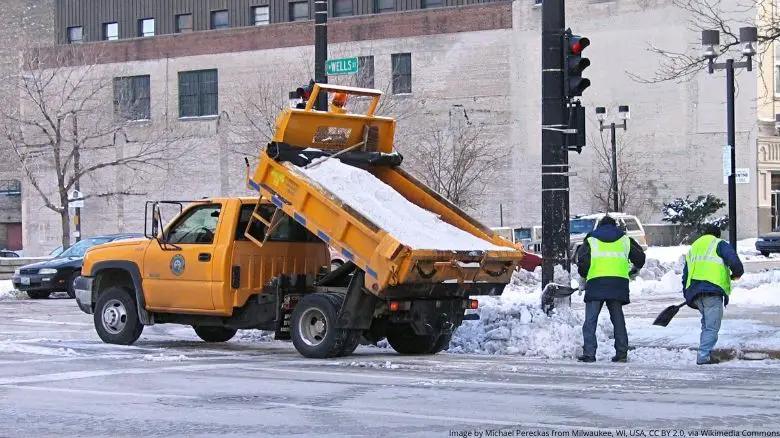
In colder climates, both the roads and the sidewalks are often covered in salt during these months.
If you live by the coast you may also notice your car rusting faster because of the salty moisture in the air.
To combat this, make sure that you wash your car more regularly during winter. Once a week during the peak salty period may be necessary, especially if you are driving the car regularly.
Focus on cleaning all the nooks and crannies of your car, as salt loves to build up there.
Use underbody sealant
Owners of older cars sometimes apply an underbody sealant to reduce the risk of rust in this area of the car, and protect the essential metal parts from the elements, such as the suspension, exhaust, and chassis.
These sealants cover the metal in a sticky layer that prevents moisture from seeping into the metal itself, although if rust has already begun forming on the car, this process will actually do more harm than good as moisture will be trapped inside.
Underbody sealants can be applied as a spray or by using a paintbrush, and there are plenty of professionals who specialize in rustproofing cars using this method.
Keep the car garaged
One of the best ways to prevent rust forming on your car is to keep your vehicle garaged. This decreases the amount of moisture that the car is exposed to over time.
However, there are a few things to consider when keeping a car garaged. Firstly, it needs to be sufficiently insulated to ensure that the temperature remains stable.
Secondly, if the garage roof, walls, or windows aren’t in good condition, there can be as much moisture inside as there is outside. If you have a damp garage with water seeping through the walls, it’s worth investing in fixing this first before you consider parking your car there long term.
You should also make sure your vehicle is dry before putting it in the garage, or you will be adding moisture to the atmosphere. Wipe it down with a microfiber towel if it’s been raining or you’ve just washed it.
You can also invest in a dehumidifer and a heater to keep the temperature up and the humidity below 50%.
Final thoughts
So, these are the seven best ways to prevent rusting on your car. Rust can not only be ugly to look at, but it can also seriously damage your car over time.
As such, it’s imperative that you deal with it as soon as you see it. And, if you don’t have any rust on your car as of yet, keep it that way with regular washing and ceramic coating applications.
It might seem like a chore now, but it will save you so much time and money in the long run, and keep your car in pristine condition.
ABOUT THE AUTHOR
Adam Chinn writes about the intersecting worlds of classic cars, driving pleasure, and smart investment strategies. Starting his journey at 26, he’s proven that one doesn’t need to be wealthy to begin investing in classic cars.
Adam’s insights have been recognized on platforms such as MoneyInc, Swagger Magazine, and Top Speed.

